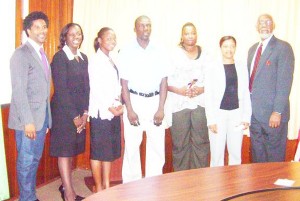Four community-based organisations on Monday received varying sums from the US Ambassador’s HIV/AIDS Fund to assist in the fight against HIV especially in the areas of stigma and discrimination.

US Ambassador John Jones presented the awards to representatives from the Youth Mentorship Endeavour (TYME), US$2,900; Kalei-doscope in Defined Shapes (KIDS TV); US$3,300; United Bricklayers, US$3,300; and the World Vision New Testament Church of God, US$500. The grants were awarded at the office of the US Centers for Disease Control and Prevention (CDC) on High Street.
Chief of Party of CDC Dr La Mar Hasbrouck said that his organisation in addition to assisting in the selection of the awardees will provide technical support for the organisations for the next few months.
In his brief remarks, Ambassador Jones referred to the projects that would be completed by the organisations with the funding provided as “quick impact projects” that can be executed quickly without any bureaucratic obstacles. He noted that the organisations would be working in the area of stigma and discrimination, which, he said, remained a challenge in the HIV fight. The ambassador also stated that the funding was made available through the US President’s Emergency Plan For AIDS Relief (PEPFAR) which over the last few years has been working with the Ministry of Health in the areas of laboratory support, counselling, testing and care and treatment.
He said Guyana has become a bona fide regional and global leader in certain aspects of the HIV campaign and he hoped that the fight would continue.
Giving brief remarks on the organizations, Hasbrouck described TYME’s project as one which is expected to assist in the reduction of infection rates among youths by increasing their access to information, education and advice on issues related to reducing the risk of HIV infections through the establishment of a youth information centre.
He said that 25 young persons are also expected to benefit from training on the subjects of sex, sexually transmitted infections, teen pregnancy and other critical issues related to reducing HIV infection.
The trained persons will in turn conduct a series of sessions with approximately 250 youths between the ages of 12 and 23 in the Tucville/ Meadowbrook areas.
KIDS TV, which will be shown on Channels 2, 11 and 67, is a project entitled ‘My Story, Your Story’, which is aimed and disseminating information on the prevention, care and control of HIV via television in the form of fun dramatic pieces. The show will be aired once a week on each station for five months.
Hasbrouck said United Bricklayers will focus on reducing vulnerability to socio-economic conditions and improving the quality of life for orphans and vulnerable children through collaborative efforts with other charitable organisations. It proposes to convene after school programmes and literacy classes that focus on issues related to HIV and other sexually transmitted diseases (STIs); remove children from high-risk situations and place them in specialized care centres with ongoing psychosocial support; and support the inclusion of children in community social structures and activities through educational tours, athletics and religion.
World Vision will focus on educating church-goers and family members on STIs and HIV prevention through abstinence and faithfulness, community mobilization, peer education, and counselling skills. Hasbrouck said the activities proposed are; awareness sessions for church members and followers on STIs and HIV with emphasis on abstinence and faithfulness; training sessions in community mobilisation for prevention, care and treatment; and sensitisation of church members on stigma and discrimination reduction strategies.





